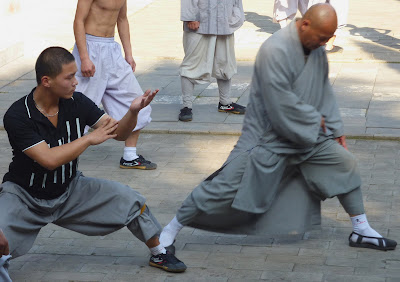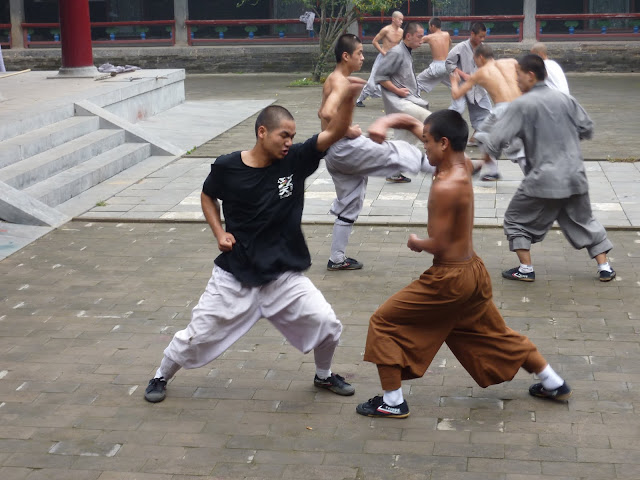The forecourt of the Shaolin Temple
少林寺 正面 的 广场
(shaolin si de zhengmian Guangchang)
Before the three large, south-facing entrance gates of the Shaolin monastery is a vast public square, which is often visited in the early morning by various groups and individuals for the practice of Qigong or Kungfu. distributed, the square faces soaring cedar trees, giving the impression of a small wood should establish before the temple. A photo in front of the main gate of the temple in the middle of the square is one of most tourists to the mandatory program. On the west side of the square are the official opening time of the temple stands in operation, offering tourist services: souvenirs, books, VCDs, calligraphy, Chinese painting. The men at these levels are not monks of the Shaolin monastery and are not related to him, they dress only "in the monastic style."
located in the central area of the square, two stone lions
sculptures from the Qing Dynasty (清代 石 狮子) flanking the main gate. They have a size of 1.67 meters and are decorated on stone pedestals of 1.75 meters. The lion is not in the nature of China before and was unknown before Christ. have Emperor Zhang Di of the Eastern Han Dynasty (76-88) it is the king of the State Anxi (in what is now Iran) will receive: Legend of the first lion was a gift to China. To disseminate the knowledge of the lion was also moving in of Buddhism in China, as the lion is a symbol of the Buddha Shakjamuni itself and its sovereignty and royal descent. Over time, China was placed in guard lions not only at the entrances of Buddhist temples and palaces before, but also from government buildings, cemeteries, hotels, restaurants, private houses, gardens and much more on. The number of locks allowed the lion sculpture in the old days to draw conclusions about the social status of their installers. How many words like probably the lions at the Shaolin Monastery have when the time senior officials were granted 13 curls?

the east and west of the forecourt are two big stone gates of honor,
"Paifang" (石 牌坊) called. The "Paifang" one of the architectural Characteristics of China. It was the gateway to large building complexes (temples, palaces, grave plants), as a monument to historical events or simply built as a symbol of a road or a village. Over time it developed but also to honor a typical symbol of Chinese feudal society, which should consolidate to strengthen their moral values. As a testimony to outstanding virtues and merits as it was for graduates of the imperial examinations or particularly meritorious officials erected. There was even honored goals for women, the extraordinary virtue and charity had proved, however, they required the explicit Genehmingung of the emperor. The origin of the "Paifang" goes far back in the history of China. It is believed that they originally came from the so-called "Torana" of Indian temple architecture. A similar example to the honorary grand gates of the stupa of Sanchi from early Buddhist period (35 BC). Is obvious. Particularly common goals in honor of the Ming and Qing dynasties were set up in Beijing alone and in Huizhou (Anhui Province) from this period are each about 100 copies obtained.
The two main gate in front of the Shaolin Monastery are facing each other and at right angles to the front of the temple aligned, they form the lateral edge of the entrance. The gate in the East dates back to 1544, 23 Year of the Ming and Jiajing with various inscriptions, including the four characters: "To Ben Yuan Tues (祖 源 谛 本) by Zhongsong Shanzi and the inscriptions" Phoenix couple and the rising sun "(双凤 朝阳) "lions and silk ball" (双狮 绣球) "On Earth and in heaven, the number one over all four oceans, famous mountains" (地 在 天 中, 海 名山 为 第一) and " Transmission durch das Herz, jenseits von Worten, - die weltweite Lehre ist der Begründer "(heart talk, the way to teach is to hire ten dollars). Das westliche Tor wurde 1555, im 34. Jahr des Ming Jiajing erbaut. Es trägt die Inschriften "Von Batuo gegründet" (Ba Tuo to create), "Zur Meditation die Wand anblicken, in stiller Nacht bringt der Wind den Ton einer Flöte" (facing the wall peak, the night was still heard about the Jin Sheng), "Junger Chan-Wald in den Song-Bergen "(Song small Buddhist temple)," Ein Pair of Jade Fountain reflected a thousand times the moonlight of autumn "(双双 玉井 碧澄 冷浸 千 秋月) and others
The southern boundary of the square is
Shaoxi River (少 溪河) , on the Built in 1846
Shaoyang Bridge (少阳 桥) out. The two bridges that crossed in the past at this point the Shaoxi River, were destroyed during rainy periods from the waters of the River. The present bridge is a simple but beautiful stone construction of 5.55 m, 37.75 m length and 5.73 m wide, in the warm season is always adorned with flowers.

* ~ * ~ ~
02 The main gate of the Shaolin Temple
少林寺 山门
The main gate of the Shaolin Temple (in direct translation: "Shaolin Temple Bergtor") consists of the massive stone terrace built on a central gatehouse and two separate, small side entrances. Center of the gate building is the large, double-leaf entrance door to a broad staircase leads up. To sites of massive wood door in the front wall, two circular windows are recessed, equally a harmonious balance with the other angular forms and a striking eye-catcher. The roof of the building is a hipped roof design with the typical curved, cantilevered Rafters, partially green-glazed brick rows and carefully sculpted ceramic figures on the ridge and into the lower regions of the Dachgrate.
The main gate was 1735 last year of the reign of the Manchu emperor Yongzheng (雍 正) of the Qing Dynasty built. Above the entrance is a plaque is mounted, with the famous logo

("Shaolin Temple") of Emperor Kangxi (康熙) , the predecessor Yongzhengs.Die calligraphy is executed in gold letters on a black background; the private seal of the Emperor ("康熙 御书 之 宝") is above the central character. Emperor Kangxi lived from 1654 to 1722. In 1704 he gave to the Shaolin Temple, two panels with engineered by his own inscriptions: the above table with the signature of the temple, which hung first on the outside of the Hall of Heavenly Kings and the construction of the main gate on at its present site to the input is appropriate. The second panel with the inscription "precious trees and fragrant Lotus" ("宝树 芳 莲"), hung in the Mahavira Hall, but it was during the war the late Qing dynasty destroyed.
located inside the gate to the front of a gilded statue of a seated Maitreya Buddha (弥勒 佛) in his appearance as a so-called "Dick Belly Buddha" (" to represent 大肚 佛) , kindness, happiness and prosperity. In the vernacular, he is also called "monk with the bag" ("布袋 和尚") called. To enter the first Tempelhof, to get open, rear portion of the gate building, one must avoid a "ghost wall" and go through a lock on an entrance fee is payable (from the Shaolin Temple receives only a small portion).

is in the back of the room an ornate display case with the statue of Bodhisattva Skanda (韦驮 菩萨) , one inherited from the Hindu pantheon Buddhist guardian deity. The Buddhist legend, Skanda was a follower of Buddha Shakjamuni and son of a king, who is also the belief in the teachings of the Buddha was met. At the entrance of the Buddha into nirvana, Skanda received from Buddha himself the task of the Dharma (the teachings) to protect them. Shortly after the burning of the physical shell of the Buddha, he protected the relics from being stolen by demons to be. One of his tasks is also to preserve the monastic community from external threats and internal conflicts. The job of protecting the Dharma, includes also the protection of the Buddhist scriptures and religious objects as well as discipline. Thus, the representation of the Bodhisattva Skanda is not only the entrance of the temples and monasteries, but also in Buddhist sutras, treatises, etc. The importance of a protective deity Skanda is also reflected in the Buddhist ceremonies. At the end of the daily morning ceremony is always the "Weituo zan" (韦驮 赞) recites a praise of the Bodhisattva and his virtues.
The figure of Skanda is part of a "military area" of Buddhist mythology. There are 4 Heavenly Kings found with 8 armies, which are commanding generals of 8 (for more see the Hall of Heavenly Kings "). Skanda is one of the 8 Generals Virudhaka the King of Heaven, which is responsible for the protection of the southern district of the universe, and also commander in chief of all the generals of the four Heavenly Kings.
There are no reliable figures on how Skanda arrived in the Chinese pantheon. There he learned in any event as a "Weituo" its own legend, which was held in the beautiful stories of Miao-Shan reflected. One of these stories in brief: Weituo, a general at the court of a cruel king falls in love with his daughter Miao Shan, which is a reincarnation of the Bodhisattva Guanyin. In view of its purity, he realizes that he can not be equal, let alone SUPERIOR partner for them. Despite the hopelessness of his love, he stays with her to worship them and protect them. He helps her to escape and set up their own empire, but the King finds them and can kill them both. Through his unconditional devotion to the Bodhisattva Guanyin General Weituo itself becomes Bodhisattva and swears to serve and protect Guanyin forever.
When General Weituo is always dressed in a splendid armor and armed with a mace. His attitude is variable, ranging from expressive, fighting poses, which reflect the use of mace, to the relatively strict frontal view in which is sometimes the mace as a support. Some representations Weituo show the Buddha greeting her chest each other down palms, while the Steitkeule lies horizontally on his arms, a pose that is also reflected at the end of a stick form of Shaolin martial arts.
; ; ;
weituoxiang * Unfortunately, the original Weituo statue of the Shaolin Temple not survived, but there is a photo of her on which can be more clearly seen as powerful, menacing and expressive it was. Today statue seems more to the sensitive Weituo of Miao-shan legend refer to

now and the General receives early morning visit from two dogs, -. maybe they bring News from the Guanyin Hall ....?
18.02.2010 - yss
protected by copyright
to images "weituoxiang" and "paifang"
* "weituoxiang" : Copyright by shaolin.cn.com all rights reserved (published here with permission from Shi Yanlong)
"paifang" Copyright by Shi Yankai all rights reserved (published here with permission from Shi Yankai)































